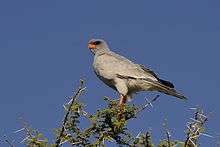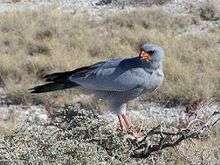Pale chanting goshawk
| Pale chanting goshawk | |
|---|---|
 | |
| Scientific classification | |
| Kingdom: | Animalia |
| Phylum: | Chordata |
| Class: | Aves |
| Order: | Accipitriformes |
| Family: | Accipitridae |
| Genus: | Melierax |
| Species: | M. canorus |
| Binomial name | |
| Melierax canorus (Thunberg, 1799) | |
The (southern) pale chanting goshawk (Melierax canorus) is a bird of prey in the family Accipitridae. This hawk breeds in southern Africa. It is a resident species of dry, open semi-desert with 75 cm or less annual rainfall. It is commonly seen perched on roadside telephone poles.
This species is 56–65 cm long. The adult has grey upperparts with a white rump. The central tail feathers are black tipped with white, and the outer feathers are barred grey and white. The head and upper breast are pale grey; the rest of the underparts are finely barred in dark grey and white. Its eyes are yellow, the bill is mostly orange, and it has long orange legs.[2] It is paler than the grey-rumped dark chanting goshawk, Melierax metabates.
In flight, the adult has black primary flight feathers, very pale grey (white from a distance) secondaries, and grey forewings. The wingspan is about 105 cm.
Immatures have brown upperparts, with a white rump and black bars on the tail. From below, the flight feathers and tail are white with black barring, the throat is dark-streaked white, and the rest of the underparts are rufous.
The pale chanting goshawk eats a variety of vertebrate prey, mainly lizards, but also small mammals and birds, and large insects. It often walks on the ground.

This is generally a rather quiet bird, but during the breeding season the male makes a series of tuneful whistling calls kleeuu, kleeuu-ku-ku-ku from a tree-top perch.
Normally a female mates with a single male, but in "broken veld" vegetation, a female and two males may form a polyandrous trio.[3]
The relatively small stick nest is built in an acacia at a height of 3 to 10 m. The female lays and incubates one or two pale bluish or greenish white, unmarked eggs. Only one chick is normally reared from a nest of two. The breeding cycle begins in midwinter and takes over 115 days.[3] The young after leaving the nest may be found near it for some months and in the following year may even display in the same area. Some pairs and especially trios raise a second brood, starting about 24 days after the first brood fledges.[3]
References
- ↑ BirdLife International (2012). "Melierax canorus". IUCN Red List of Threatened Species. Version 2013.2. International Union for Conservation of Nature. Retrieved 26 November 2013.
- ↑ Sinclair, Ian; Hockley, Phil; Tarboton, Warwick; Ryan, Peter (2011). SASOL birds of Southern Africa. Struik Nature. ISBN 978-1-77007-925-0.
- 1 2 3 Malan, G.; Crowe, T. M.; Biggs, R.; Herholdt, J. J. (2008), "The social system of the Pale Chanting Goshawk Melierax canorus; monogamy v polyandry and delayed dispersal", Ibis, 139 (2): 313–321, doi:10.1111/j.1474-919X.1997.tb04630.x (Abstract only for non-subscribers.)
External links
| Wikimedia Commons has media related to Melierax canorus. |
- Pale Chanting Goshawk - Species text in The Atlas of Southern African Birds
- Pale Chanting Goshawk, The Hawk Conservancy
- Melierax canorus, Biodiversity Explorer
- Southern Pale Chanting Goshawk, Oiseaux
